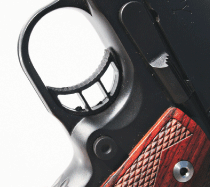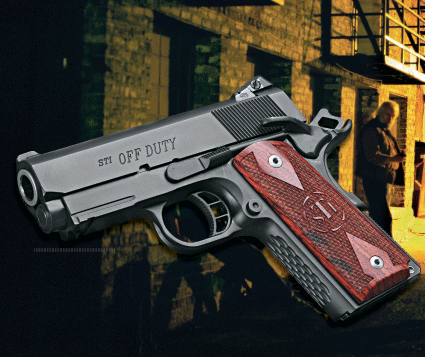My comfort factor continues to run high with the technology that has served me well for years. If somebody made a cellular phone with a rotary dial, I would probably buy it.
 My choice in carry guns doesn’t stray far from the familiar. I’m very comfortable with the polymer frame self-loader I carried for the last 20 years of my law enforcement career. For a hideout gun, I continue to pack a Smith & Wesson J-frame. My first autopistol was a 1911 and I still haven’t found anything I can shoot to a higher standard. However, I am very particular as to what 1911 I might trust with my life.
My choice in carry guns doesn’t stray far from the familiar. I’m very comfortable with the polymer frame self-loader I carried for the last 20 years of my law enforcement career. For a hideout gun, I continue to pack a Smith & Wesson J-frame. My first autopistol was a 1911 and I still haven’t found anything I can shoot to a higher standard. However, I am very particular as to what 1911 I might trust with my life.
I’ve observed that the most reliable 1911s are full size .45ACP pistols built on steel frames. Sure, I’ve owned and shot many 1911s in different configurations and chamberings, but reliability isn’t quite as good as the original format. Quite frankly, I’ve had little use for anything smaller than a Commander size gun and even these I view with suspicion.
Advertisement — Continue Reading Below
At a show, I came across a most impressive array of 1911 pistols by STI of Georgetown, Texas. STI has been turning out some impressive competition and carry guns since the early ‘90s and I was impressed with many of the offerings on display. Rabbit Boyett of STI suggested I take a look at their Off Duty, a really small and compact 1911 designed for the concealed carry mission.
Rabbit was absolutely certain that the Off Duty would win me over, but I was skeptical. If the Off Duty ran like the other chopped and channeled 1911s I’ve tested in the past, it would be best used as a weight in a crab trap. Having an open mind, I agreed to Rabbit’s challenge. In a few short weeks, I had the Off Duty in hand, prepared to give it a serious workout.
Gun Details
Initial examination of the STI Off Duty led me to believe it was definitely a high quality gun. Fit and finish were excellent and it appeared to have all the qualities of a first class concealment pistol.
Advertisement — Continue Reading Below
Slide, barrel, and frame were all abbreviated to enhance discreet carry. Total length of the Off Duty is 7 inches, which makes it easy to conceal in an IWB holster. The fully supported ramp barrel measures 3 inches in length. Height has been reduced to 5 inches and the shortened grip frame harbors a 6-shot magazine. An undercut triggerguard aids one in getting a high grip for better control.
Both the slide and frame of the STI Off Duty are crafted from carbon steel. Unloaded, this little blaster tipped the scales at 31.3 ounces. This is a few ounces heavier than like-size polymer and alloy frame subcompacts, but the extra beef helps keep recoil in check. Metal surfaces are finished in non-reflective business-like matte blue. Grip panels are made of attractive cocobolo and sport the STI logo.
The front strap of the Off Duty wears a “tire tread” STIppling pattern for a positive hold. To further enhance shooter control, a flat-checkered mainspring housing is utilized.
Advertisement — Continue Reading Below
Diagonal cocking serrations on the rear of the slide provide a positive gripping surface for manual slide manipulation. The ejection port cut in the slide is oversized to make sure empty cases are ejected well clear of the gun.
The Off Duty is equipped with a single side, frame mounted thumb safety. This southpaw requires an ambidextrous switch, but the standard safety will please the right-handed 88% majority of the shooting fraternity. STI equips the Off Duty with their knuckle relief beavertail grip safety for positive operation under stress. The magazine well is beveled to make reloading as fumble free as possible.
Sights on the Off Duty are a cut above. I’m generally not a fan of the 3 dot pattern, but the STI combo is an easier read than most. The front sight is dovetailed to the slide and the Novak style rear is adjustable. Horizontal serrations on the face of the rear sight eliminate glare and make it easier to clearly identify the front sight when shooting quickly. Tritium night sights are available as an option.
Advertisement — Continue Reading Below
One curious feature of the Off Duty was a fully integrated tactical rail. This frill has become standard equipment on just about all modern service pistols, but this was my first experience with this setup on a subcompact 1911. Both lights and laser aimers can be adapted to the Off Duty and I tried my sample out with a Safariland RLS (Rapid Light System), LaserMax Uni-Max Aimer, and an Insight Tech-Gear X2 light/laser combo.
All things considered, the Off Duty had the look of a winner. But only a serious workout at the range would tell the real story.
Check out our article: The Pros & Cons of Public & Private Gun Ranges
Advertisement — Continue Reading Below
STI Trigger Time
To break the ice, I fired several magazines of ball ammo at a target set just a few yards away. Everything seemed to be in order and I was particularly impressed with its trigger. The trigger was relatively crisp and broke at about 5 pounds. I was able to pick up the sights fairly quickly, a real bonus for my middle-aged eyes.
Felt recoil is a subjective factor and we all perceive it a little differently. You certainly knew when this pistol went off, but I didn’t find it punishing in any way. In fact, comfort factor with the all steel Off Duty is far superior to similar size .45ACP pistols built on alloy frames.
Next, I moved on to the chronograph to see what effect the short barrel might have on muzzle velocity. Predictably, velocities are down a bit from a full size 1911, but I really can’t get too excited about that. Modern .45ACP from reputable manufacturers will still expand and get the job done, even at subsonic velocities. CorBon’s fully copper DPX bullet posted the highest muzzle velocity and averaged 1059 feet per second (fps). Heavy bullet fans may want to check out Federal’s HST 230-grain +XP JHP, which hit 844 fps.
Advertisement — Continue Reading Below
Practical accuracy was assessed by firing 5-shot groups from a distance of 10 yards standing, unsupported. Shots were fired at a cadence of one shot per second. Alright, we may have stretched that timeframe a bit, but my Competition Electronics PocketPro timer kept me fairly honest. As soon as the front sight settled on the target, I triggered off the next shot, doing so until all five rounds were expended.
Best performance was achieved with Winchester Silvertip 185-grain JHP. I really didn’t find this too surprising since Winchester load has proven to be very manageable in my other .45ACP pistols. All loads tested fell into a 3-inch circle or less when fired at this relatively short range.
Final Thoughts
New officers often ask me as to what the best gun for off duty carry might be. My answer has long been the same gun you carry on duty. Full-size guns hold more bullets, have full-length grip frames, and a longer sight radius. One is also likely to log more training time on the duty gun and will be able to shoot it to a higher standard. In reality, few coppers are willing to carry that service pistol on a full time basis.
Advertisement — Continue Reading Below
Well, if your service pistol won’t do, the next best thing is a smaller version of the same. The learning curve isn’t nearly as steep since vital controls are in the same place and grip angle is unchanged. Trigger action is identical as well. If your preferred carry gun is a full size 1911, the STI Off Duty is an excellent choice for more discreet carry.
Subcompact pistols like the STI Off Duty can be effectively hidden on the belt. I’ll confess to carrying a snub revolver in the pocket or on the ankle, but for belt carry, the Off Duty is a better bet. It’s easier to fire accurately under stress, holds more rounds, and produces better stopping potential than any snub revolver. Needless to say, the Off Duty has capabilities far beyond any pocket pistol that might be worn on the belt.
Qualities of a good defensive pistol include reliability, accuracy, decent sights, and a good trigger. The STI Off Duty offers all of that and more. If a chopped and channeled 1911 races your motor, the Off Duty stands out as one of the best.
Advertisement — Continue Reading Below























